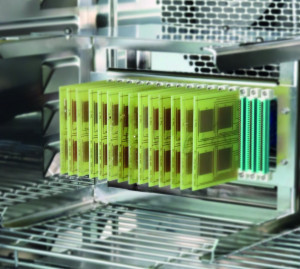In order to determine the electrical safety of fluxes in soldering technology, the surface insulation resistance must be measured. Specifically, the insulation resistance between neighboring conductors on the surface of a printed circuit board is determined. This is done using so-called SIR tests.
SIR tests play an important role in both product development and product classification. Under precisely defined test conditions, the SIR values of an energized PCB are recorded over a defined period of time. The test result provides information on whether the flux used is electrically safe. This is because if unsafe fluxes are used in soldering processes, they can cause short circuits on the PCBs. This can lead to production or machine failures or defective end devices. "SIR tests are an absolute must for soldering agents used in the electronics industry," explains Diana Merkwitz, SIR test expert at Stannol. "However, it also depends on which standard is used for testing."
Tests according to IPC J-STD-004C
 Diana Merkwitz has been responsible for carrying out SIR tests in Stannol's in-house laboratory for 17 yearsStannolhas recently started carrying out SIR tests for its own products exclusively in accordance with the current American guideline IPC J-STD-004C[1]. This standard characterizes and classifies fluxes for leaded and lead-free solders and is currently considered one of the strictest standards in the world. "Customers from the automotive, aerospace and medical technology industries in particular attach great importance to the fact that the fluxes used are electrically safe. Stannol tests its products according to this standard because the test conditions specified in it place particularly high demands on the tested products and therefore on their safety," emphasizes Merkwitz. If a flux is to be classified according to this standard, the SIR test is one of several tests that have to be carried out.
Diana Merkwitz has been responsible for carrying out SIR tests in Stannol's in-house laboratory for 17 yearsStannolhas recently started carrying out SIR tests for its own products exclusively in accordance with the current American guideline IPC J-STD-004C[1]. This standard characterizes and classifies fluxes for leaded and lead-free solders and is currently considered one of the strictest standards in the world. "Customers from the automotive, aerospace and medical technology industries in particular attach great importance to the fact that the fluxes used are electrically safe. Stannol tests its products according to this standard because the test conditions specified in it place particularly high demands on the tested products and therefore on their safety," emphasizes Merkwitz. If a flux is to be classified according to this standard, the SIR test is one of several tests that have to be carried out.
Climatic chamber and measuring device
The standard specifies the exact climatic conditions under which the tests are to be carried out and which conductor geometry must be used, i.e. the thickness and spacing of the conductors, for example. It also precisely defines parameters such as current intensity and test duration. The prepared test boards are attached to two test racks in the climate chamber with edge connectors, connected to the external measuring device and energized. The test boards are positioned so that the prepared circuit boards are parallel to the air flow. Temperature and humidity are then slowly increased via a ramp until the desired values are reached. The measuring device then records the SIR values of each individual comb on the PCBs at 20-minute intervals. "The recorded measured values can now be easily read out. For each test structure, it is possible to see exactly if and when there was a drop in the required resistance somewhere."
High humidity as an endurance test
SIR measurements are complex: The tests have to be carefully prepared and carried out over a long period of time. Diana Merkwitz: "The pure duration of an SIR test is one week. In addition, there is the preparation of the PCBs - these must first be prepared with the flux or solder wire to be tested according to the special specifications." The SIR tests in accordance with IPC J-STD-004C create a kind of worst-case scenario: The prepared PCBs are exposed to current in a climate chamber at 40 °C and 90 % relative humidity. "In contrast to the older -004A standard, measurements are taken at a lower temperature but at a higher humidity. This means it is colder, but at the same time more humid. In addition, the distances between the conductor tracks on the test structure are smaller according to standard -004C. Both are an absolute endurance test for the flux used," emphasizes the expert.
Dendrites are a knockout criterion
 Prepared test boards in the climate chamber. Climate: Temperature 40 ± 1 °C / Relative humidity 90 ± 3 % over 168 hoursThestandard also requires a resistance of at least 108 ohms, which must be maintained over a period of 168 hours. Here too, the C standard is stricter: This is because this resistance must be achieved after 24 hours at the latest and then maintained until the end of the test. For the previous version, it was sufficient for this resistance to be reached shortly before the end of the test. During the test, the resistance must not fall below 108 ohms - otherwise the test is deemed to have been failed. The exception: the resistance only drops in places, for example because the circuit board is contaminated by a fiber or because a bridge has formed due to tin during soldering. "We don't test in a clean room, but under real conditions. We use the material in the same way as in production. Therefore, such impurities are normal. If the microscope clearly shows that the resistance has only decreased due to contamination, this has no negative impact on the test result," emphasizes the expert. Under no circumstances should dendrites be allowed to form during the test. Dendrites are bush-like branches of copper that form between the conductors and lead to a short circuit. "This is an absolute knock-out criterion: if dendrites form or the distance between the PCBs is reduced by more than 20% due to so-called electrochemical migration, the test is deemed to have failed. The flux would then not be electrically safe."
Prepared test boards in the climate chamber. Climate: Temperature 40 ± 1 °C / Relative humidity 90 ± 3 % over 168 hoursThestandard also requires a resistance of at least 108 ohms, which must be maintained over a period of 168 hours. Here too, the C standard is stricter: This is because this resistance must be achieved after 24 hours at the latest and then maintained until the end of the test. For the previous version, it was sufficient for this resistance to be reached shortly before the end of the test. During the test, the resistance must not fall below 108 ohms - otherwise the test is deemed to have been failed. The exception: the resistance only drops in places, for example because the circuit board is contaminated by a fiber or because a bridge has formed due to tin during soldering. "We don't test in a clean room, but under real conditions. We use the material in the same way as in production. Therefore, such impurities are normal. If the microscope clearly shows that the resistance has only decreased due to contamination, this has no negative impact on the test result," emphasizes the expert. Under no circumstances should dendrites be allowed to form during the test. Dendrites are bush-like branches of copper that form between the conductors and lead to a short circuit. "This is an absolute knock-out criterion: if dendrites form or the distance between the PCBs is reduced by more than 20% due to so-called electrochemical migration, the test is deemed to have failed. The flux would then not be electrically safe."
Stricter than the standard requires
In some areas, Stannol even goes beyond the required parameters of the directive. "The standard actually requires ten test combs for testing fluxes in solder wires. However, we use a total of 16 combs. This not only results in a larger test field, but also an increase in safety," explains Merkwitz. Stannol also sets tougher conditions for the SIR tests of liquid fluxes - by voluntarily adding a complete test scenario. This is because the standard only prescribes two scenarios: First, three PCBs (twelve combs) of the test boards must be sprayed with flux and the traces soldered. Secondly, three PCBs must be treated with flux and the back of the PCB must be moved over the solder wave (upside-down). The third scenario at Stannol involves spraying additional PCBs with flux and drying them at room temperature only. Diana Merkwitz: "This is intended to simulate the process in a selective soldering system, in which the flux is also not exposed to heat. We want to know how it behaves under these circumstances and whether it can still be used safely."
The following are required for an SIR test:
- Wave soldering system (for separate flux)
- Soldering iron (for flux in solder wires)
- Printed circuit boards prepared according to standard specifications
- climatic chamber
- SIR measuring device, e.g. AutoSIR 2+ from GEN3 Systems
SIR tests for customers
Stannol not only carries out SIR tests for its own products, but also offers this service to external companies. A special SIR test for precisely this combination can make sense, especially when it comes to the combination of different fluxes on a PCB, for example because different soldering processes with different soldering agents are used during assembly. For this purpose, the customer sends fully prepared PCBs to Stannol, which are then tested in the in-house laboratory in close consultation. "We not only carry out the measurement, but also prepare a detailed report afterwards. If the test result is not satisfactory for the customer, we can provide tips on how the processes can be changed so that the result is better, for example by selecting different compositions or combinations," explains Merkwitz.


